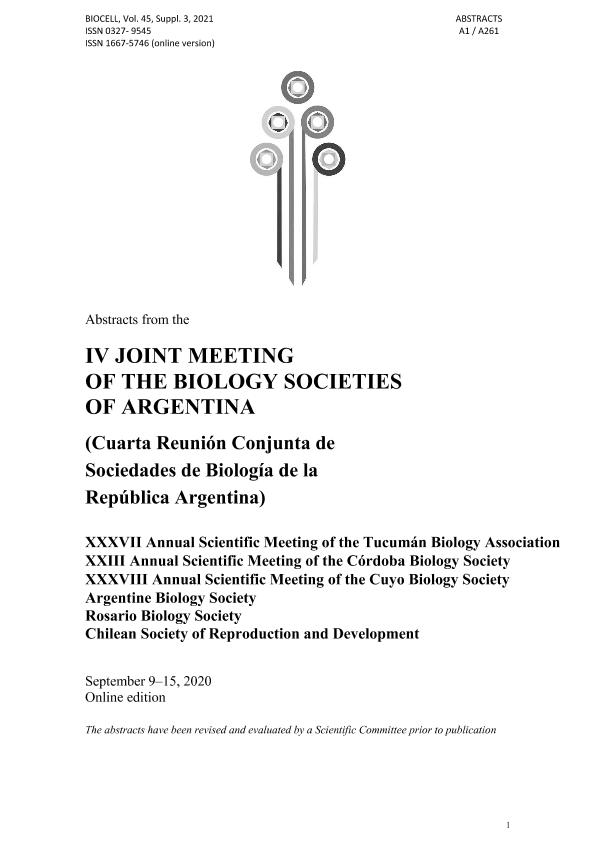Evento
Building an experimental nutritional model of obesity. Evaluation of anthropometrical and nutritional parameters
Alfonso, Javier Oscar ; Lopez, Mariana; Delgado, Silvia Marcela; Navigatore Fonzo, Lorena Silvina
; Lopez, Mariana; Delgado, Silvia Marcela; Navigatore Fonzo, Lorena Silvina ; Anzulovich Miranda, Ana Cecilia
; Anzulovich Miranda, Ana Cecilia
 ; Lopez, Mariana; Delgado, Silvia Marcela; Navigatore Fonzo, Lorena Silvina
; Lopez, Mariana; Delgado, Silvia Marcela; Navigatore Fonzo, Lorena Silvina ; Anzulovich Miranda, Ana Cecilia
; Anzulovich Miranda, Ana Cecilia
Colaboradores:
Ajmat, María Teresa; Borioli, Graciela

Tipo del evento:
Congreso
Nombre del evento:
IV Reunión Conjunta de Sociedades de Biología de la República Argentina: “Nuevas Evidencias y Cambios de Paradigmas en Ciencias Biológicas”
Fecha del evento:
09/09/2020
Institución Organizadora:
Sociedad de Biología de Cuyo;
Universidad Nacional de Cuyo;
Sociedad Argentina de Biología;
Sociedad de Biología de Córdoba;
Sociedad de Biología de Rosario;
Asociación de Biología de Tucumán;
Honorable Legislatura de la Provincia de Mendoza;
Sociedad Chilena de Reproducción y Desarrollo;
Ministerio de Salud Provincia de Mendoza;
Gobierno de la Provincia de Mendoza;
Título de la revista:
Biocell
Editorial:
Tech Science Press
ISSN:
0327-9545
e-ISSN:
1667-5746
Idioma:
Inglés
Clasificación temática:
Resumen
The etiology of obesity is multifactorial, and includes genetic, environmental, and dietary factors, where hypercaloric diets play a central role in the development of the disease. It is known that obesity in adulthood can increase the risk of suffering neurodegenerative diseases. As a part of an institutional project that studies obesity as a base disease for the development of chronic age-associated diseases and the search for early biomarkers with predictive potential, one of our general objectives is to establish a nutritional model of obesity in rat. Particularly, the objective of this work was to evaluate the effects of a high saturated fat diet on different anthropometric and nutritional parameters. Male Wistar rats weaned at 21 days of age were fed with a normocaloric diet (ND) containing 366 kcal from lipids/kg diet. At 2 months old, they were randomly separated and fed with the NC diet (Control group) and a high saturated fat diet containing 1570.7 kcal from margarine/kg diet (HFD group) for the following 14 weeks. Animals were maintained under 12 h light:12 h dark and 22–24°C conditions, with food and water ad libitum. The anthropometric profile included the evaluation of food intake, body weight, body mass index (BMI), weight gain, dietary consumption, and Lee index, throughout the entire treatment period. The following nutritional parameters were also calculated: energy-intake, and feed efficiency. Statistical differences between groups and throughout the treatment period were analyzed by two-way ANOVA, followed by Bonferroni post-hoc test, with P < 0.05 to confirm significant differences between groups and weeks. Our results show that feeding HFD resulted in significant increases in the following anthropometric parameters: body weight (P < 0.001 from the 9th to the 21st week), BMI (P < 0.05 from the 14th to the 22nd week), weight gain (P < 0.05 from the 15th to the 22nd week) as well as in the nutritional parameter: energy-intake from lipids (P < 0.001 from the 9th to the 22nd week). We did not observe significant changes in food intake, Lee index, feed efficiency nor in the total energy intake. Thus, we could conclude that a high saturated fat, from margarine, diet modifies key anthropometrical and nutritional parameters, and it could be used to establish a nutritional model of obesity in rat.
Palabras clave:
NUTRITIONAL MODEL
,
OBESITY
,
RAT
,
ANTROPOMETRIC PARAMETERS
Archivos asociados
Licencia
Identificadores
Colecciones
Eventos(IMIBIO-SL)
Eventos de INST. MULTIDICIPLINARIO DE INV. BIO. DE SAN LUIS
Eventos de INST. MULTIDICIPLINARIO DE INV. BIO. DE SAN LUIS
Citación
Building an experimental nutritional model of obesity. Evaluation of anthropometrical and nutritional parameters; IV Reunión Conjunta de Sociedades de Biología de la República Argentina: “Nuevas Evidencias y Cambios de Paradigmas en Ciencias Biológicas”; Argentina; 2020; 104-104
Compartir



